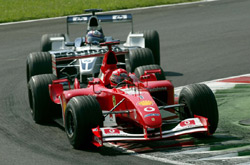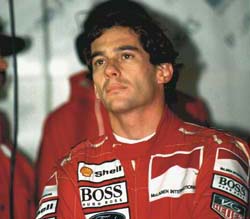
So for anyone hoping to get past Michael Schumacher, you need a car one and a half seconds quicker than the Ferrari? Surely not? The solution is hard to tie down. Formula One cars do still, it seems, give a 'tow' to cars behind them on the straight. But the problem is that the aerodynamics on each car are now so advanced that they throw up massive turbulence too. That makes it impossible to follow a car in front round any fast corners - as drivers have to wait too long for the front of the car to stabilise before they can get on the power again. So if a straight comes after a fast corner, forget it.
"You can get to within about eight-tenths of a second of the car in front," says BAR's Jenson Button. "But then you just lose grip everywhere round the circuit. That's especially true for high speed corners - it really hurts through somewhere like Monza's Parabolica."
"The good thing is that you gain on the straight, but the stupid thing is that you can't get close enough to do anything. That means that the only way to get past anyone is in the pits and at the start. It's a nightmare, but that's the only way - for us."
If all you need to overtake are slow corners leading to long straights, then one major culprit has to be the current selection of modern Formula One tracks. The old Hockenheim was a perfect example of a track built for overtaking. Only two years ago, Barrichello claimed his first F1™ win from 18th on the grid - drafting past almost every car in the field. No trouble with the likes of Button there. The only problem is, they've now rebuilt Hockenheim to be like pretty much any other track on the calendar.
Barrichello, for one, is fed up with that decision: "We should change the circuits to suit overtaking," he says. "Hockenheim was a good one, but the problem was that the road through the forest was dangerous because when it was raining, the spray hung in the air. And then there was a political problem that you can't cut the trees down."
"Yet we still go to Hungary and Monaco, where we are never going to see any overtaking. On those two tracks, we could be in F1 cars and the others in F3000 cars, and we still couldn't get past."
Montoya reckons that it's not all doom and gloom on the track front, however, adding: "Some of the newer tracks are good for overtaking. Malaysia's a really good track. There are two long straights that come after slow corners where you can follow people, and hopefully 'draft' them. And then there are corners where it's quite easy to make a mistake under braking."
Moves are now underway to guarantee that any country hoping to gain one of the prized spots on the F1 calendar has to provide a circuit where you can overtake. But short of turning every track into a long oval, with hairpins at either end of a two-mile straight, the cars are still the problem. If we want to see the very fastest cars, it seems we have to put up with a bit of hardship.
Jaguar's Mark Webber is one who sees the benefit of change, but also appreciates that the fans like what they see at the moment. "The best racing is Formula Ford and go-kart, because if you're quicker, you're past, it's as simple as that. You can just sit on someone's gearbox and just keep pushing their rear light and you'd be fine. But once you get to something like F3000 it's nearly as difficult as it is in F1."
"The wings give us all this downforce, which makes it awesome for us to drive, and awesome for the spectators to watch. So it's a vicious circle. It's not easy. We need to keep the spectacle of cars lapping in unbelievable times, braking very late, but it's hard for us to overtake."
You encounter a similar vicious circle if you start asking drivers for the ultimate solution - everyone has a different answer. Barrichello, for example, attributes a major increase in the problem to the change to grooved tyres in 1998.
"At the front of the field, it's always going to be difficult to overtake," he says. "But when they introduced the grooves, it became a bit more difficult. Back in 1993 we had a lot more downforce, and it seemed easier. With slicks we could probably have a bit more mechanical grip to overtake with."
Webber, by contrast, reckons that the current grooved tyres have improved so much in the course of the last five years that they are now better than any of the slick tyres were up to 1997. And Montoya reckons the grooves actually help overtaking anyway.
"Having the grooves is a good tool for making mistakes," adds the Colombian. "The best way to improve overtaking would be to put a lot of downforce in the car from underneath the wings. That way you could follow people round fast corners, like in Formula Ford. You take the wings off, put in a smaller engine, and get most of the downforce from underneath the car."
He is more or less taking about ground effect. Formula One has been down that
road before and the advantages of grip are arguably outweighed by the dangers of
a sudden breakage. Cars also lose their tendency to move around and slide at the
rear - a spectacle that every fan likes to see. It is like watching cars going
around on rails.

Grooves were introduced as a result of scientific analysis of the various corners in the sport following Ayrton Senna's death at Imola in 1994. Decrease corner speed even a few miles an hour, they discovered, and the safety quotient goes up dramatically. Hence the reason we are where we are.
And that is where the proponents of the current brand of racing come from: they say that America's recipe (seen most graphically in NASCAR and CART oval races) of dozens of overtaking moves a lap is far from dramatic. The drama of the move comes from the build-up, the anticipation: rather like a goal in soccer. If it was easy the value would decrease, they insist.
But how about the other extreme - Formula One cars without wings? Well, that brings up the final cog in the equation, and the basic reason why we'll probably have to make do with what we have, at least for the foreseeable future; finance and spectacle.
Button sums it up neatly: "The cars would look pretty stupid, and you wouldn't have any sponsors, so F1 wouldn't exist, would it?" As you can see, everyone has their own point of view.